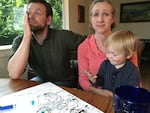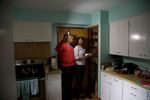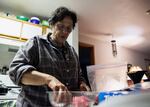
The Alexanders take a look at OPB's Aftershock tool. "We could be looking at a house that's uninhabitable," said Patrick Alexander.
Amanda Peacher / OPB
Ed and Sara Johnson cook a meal of vegetarian chili by the light of headlamps. After they eat, Sara turns on the faucet, stops herself and begins laughing.
"You do things so many times without thinking about it. I just turned the water on. I forgot," she said. "There’s a sign on it that says ‘do not operate’ and I still turned on the water."
On Friday night, four Oregon households began a weekend-long test of their disaster readiness. They'll spend the next two days taking on various earthquake-related challenges and seeing how well their supplies hold up during OPB's "
" drill.

Sara and Ed Johnson shine a flashlight in their pantry to see what they can make for their first "Living Off Your Quake Kit" dinner. The Johnsons have a flashlight in each room of their house.
John Rosman / OPB
The Johnsons, a southeast Portland couple, threw themselves into the challenge immediately by shutting down their power and turning on their flashlights.
"We’re trying to have a real experience. The only way we can really do that is by adjusting our lifestyle for the weekend. And it starts now," Ed said.
Seismologists predict that the Northwest has a 37 percent chance of experiencing an 8.0 or 9.0 earthquake in the next 50 years.
After the families ate their final meals for the weekend that wouldn't be coming from their emergency supplies, they checked out OPB's
, which provides a megaquake simulation based upon a person's address.
"We could be looking at house that is uninhabitable," said Patrick Alexander, after seeing what an 8.0 or 9.0 earthquake could do to his family's home in Lincoln City.
Patrick and his wife, Krista Eddy
, realized that their house was built in the 1960s, and is less likely than newer homes to hold up in an earthquake. They were shocked at how long it would take to restore gas, water and especially medical services to their area.
Though the Alexander home is outside the tsunami zone, they know that many of their family and friends are at risk.
"You assume that you're planning for your family, but if our house is still standing we'll be providing for more," said Patrick.

Brook Gowin prepares dinner before the simulated quake for the "Living Off Your Quake Kit" weekend.
Alan Sylvestre / OPB
Brook Gowin, who lives with her cat KeeKee in Troutdale, ate a hamburger and potato salad as her pre-disaster meal before she reviewed her Aftershock scenario. She said she was surprised how strong the shaking could be, but also wasn't necessarily worried about her survival after the earthquake.
"I think I'd realize that it's an earthquake. I don't usually panic in those types of situations," she said. "If you panic in situations like this, then you'll be dead."
Though the Stephens family of North Portland plans to spend the weekend making the simulation as realistic as possible by locking the doors to their home and camping in tents, Megan Stephens says part of her knows it's nothing compared to the real thing.
"I've been struck by how easy this is to do compared to how it would really be. Making sure we have pillowcases on our pillows, setting up the tents yesterday," she said. "If we survived the quake, we would just be fleeing to the backyard with nothing."
The Stephens kids, 11-year-old Shea and 10-year-old Sadie, are surprised to see that it could take up to two years for hospitals to be fully functional after the earthquake in their Aftershock scenario. Father John Stephens — a program coordinator for Mercy Corps — asked them to think about what they'd do if they were hurt.
Shea remembered they have a first aid kit with a splint in it, and John reminded him about a family friend who's a doctor.
But the real surprise was how much food they learned they're supposed to have on hand to survive a Cascadia Subduction Zone quake.

The Stephens family feels they're overall prepared for a natural disaster, but are concerned they do not have enough water stored at their house.
Amelia Templeton / OPB
Megan’s jaw dropped. Sadie calculated that the family needs about 168 meals for a family of four. “That’s just for two weeks?” Shea asked, incredulous.
“Here’s what I was thinking about. What if we actually had all the food we need, and were feeling pretty good, but our neighbors come over? What If another family said we forgot to pack food?” John asked.
“I’d slam the door!” Shea said.
“What if they’re close friends? What if Ezra came over?” Meagan asked.
Sadie took a moment to think. “I’d give her half my chicken noodle soup,” she declared.
With that, the reality of the weekend sank in, and the kids sneaked into the kitchen to each fix themselves another dinner.